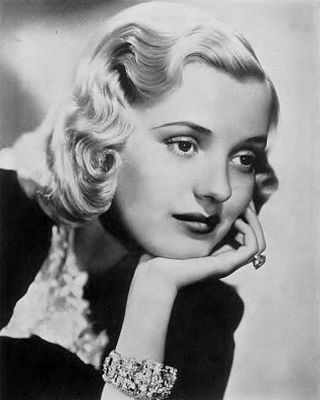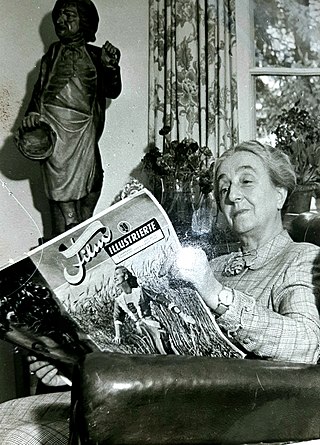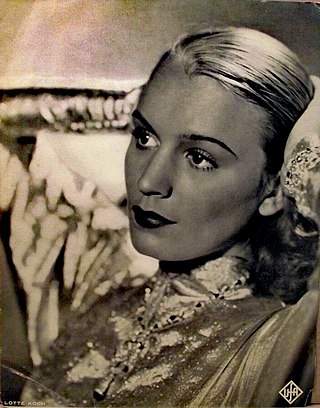
Brigitte Horney was a German theatre and film actress. Best remembered was her role as Empress Katherine the Great in the 1943 version of the UFA film version of Baron Münchhausen, directed by Josef von Báky, with Hans Albers in the title role.

Phyllis Brooks was an American actress and model. She was born in Boise, Idaho. Some sources have also inaccurately cited 1914 as her year of birth, but 1915 is the correct year according to Social Security records.

Somewhere in Berlin is a film produced in the Soviet occupation zone of Allied-occupied Germany, the area that later became East Germany. It was released in 1946, and was the third DEFA film. It sold 4,179,651 tickets. It was part of the group of rubble films made in the aftermath of the Second World War.
Karl Hannemann was a German film actor.

Lotte Neumann was a German film actress, screenwriter, and film producer.
Herbert B. Fredersdorf was a German film editor, screenwriter and film director.
Karl Georg Külb (1901–1980) was a German screenwriter and film director.
Georg Bruckbauer was an Austrian cinematographer who worked on over 120 films during his career.
Gustav Püttjer was a German film actor who appeared in around 150 feature films between 1927 and 1959. He largely played character parts. After the Second World War he settled in East Germany appearing in the films of the state-controlled company DEFA.

Georgia Lind (1905–1984) was a German stage and film actress. She appeared in a mixture of leading and supporting roles in films. From the mid-1930s she devoted herself increasingly to the theatre, and post-Second World War she also did a large amount of radio work. One of her final film performances was a small role in Robert A. Stemmle's Berliner Ballade (1948). She was married to the actor Rudolf Platte.

Margarete Haagen was a German stage and film actress. Haagen appeared in over a hundred films during her career, generally in character roles. She specialised in playing good-natured elderly ladies. Following the Second World War, she appeared in several rubble films, such as In Those Days (1947). During the 1950s, she often appeared in heimatfilm and costume films.
Gaston Briese was a German stage and film actor. He appeared in more than forty films during his career, which spanned from the late silent era to the mid-1940s. His final appearance was in the 1946 rubble film Somewhere in Berlin.
Walter Wischniewsky was a German film editor who worked on over a hundred productions during his career. Wischniewsky also sometimes worked as an assistant director. Wischniewsky began his career during the Nazi era, but most productions he worked on were post-Second World War. He edited several rubble films, including The Berliner (1948). During the 1950s and 1960s he became one of the mainstays of German commercial cinema, working on the long-running Edgar Wallace and Karl May series. Wischniewsky edited Fritz Lang's Indian-shot The Indian Tomb and The Tiger of Eschnapur.

Lotte Koch was a Belgian-born German film actress. She emerged as a star during the Nazi era, appearing in the 1944 drama The Black Robe. Following the Second World War she appeared in several rubble films including And the Heavens Above Us (1947) with Hans Albers.
Annemarie Hase was a German actress and cabaret artist. She emerged as a star during the Weimar Republic, but because she was Jewish she faced increasing persecution following the Nazi takeover in 1933. In 1936 she went into exile in Britain, where she remained for the next decade. She was involved with various exile groups, and was employed by the BBC during the Second World War where she worked alongside Bruno Adler.
Alice Ludwig was a German film editor who worked on many films and television series between 1932 and 1973. After first entering the film industry during the Weimar Republic, she worked continuously during the Nazi era. Following the Second World War she edited Marriage in the Shadows (1947), an anti-Nazi work of the rubble film period. Much of her later film work was in popular melodramas such as Gabriela (1950). From the 1960s onwards she switched to working in television, her final employment being the editing over fifty episodes of the crime series Hamburg Transit.

Günter Christian Ludwig Neumann was a German singer, composer lyricist, cabaretist and screenwriter. He contributed to many popular songs and worked frequently in the German film industry on productions such as The Berliner (1948).

Edith Meinhard was a German actress who appeared in more than fifty films during her career including the 1929 film Diary of a Lost Girl.
Gabriel Pellon (1900–1975) was a German painter and art director. Pellon was born in Metz, which was then part of the German Empire having been annexed from France at the end of the Franco-Prussian War. When Metz was later annexed by France, Pellon settled in Germany where he established himself as a leading designer of film sets.
Bruno Monden (1900–1980) was a German art director. He designed the sets for several rubble films in the wake of the Second World War.








